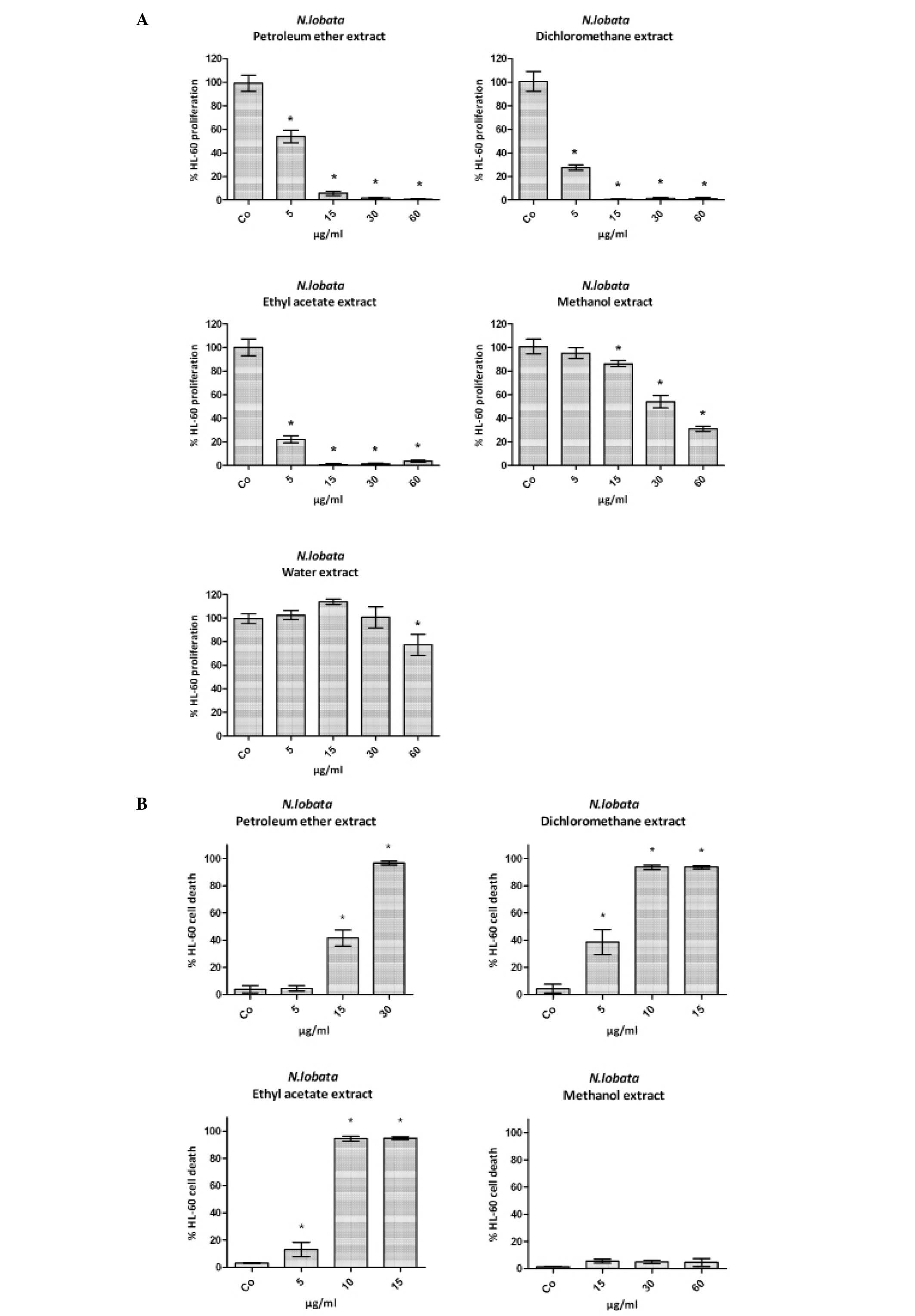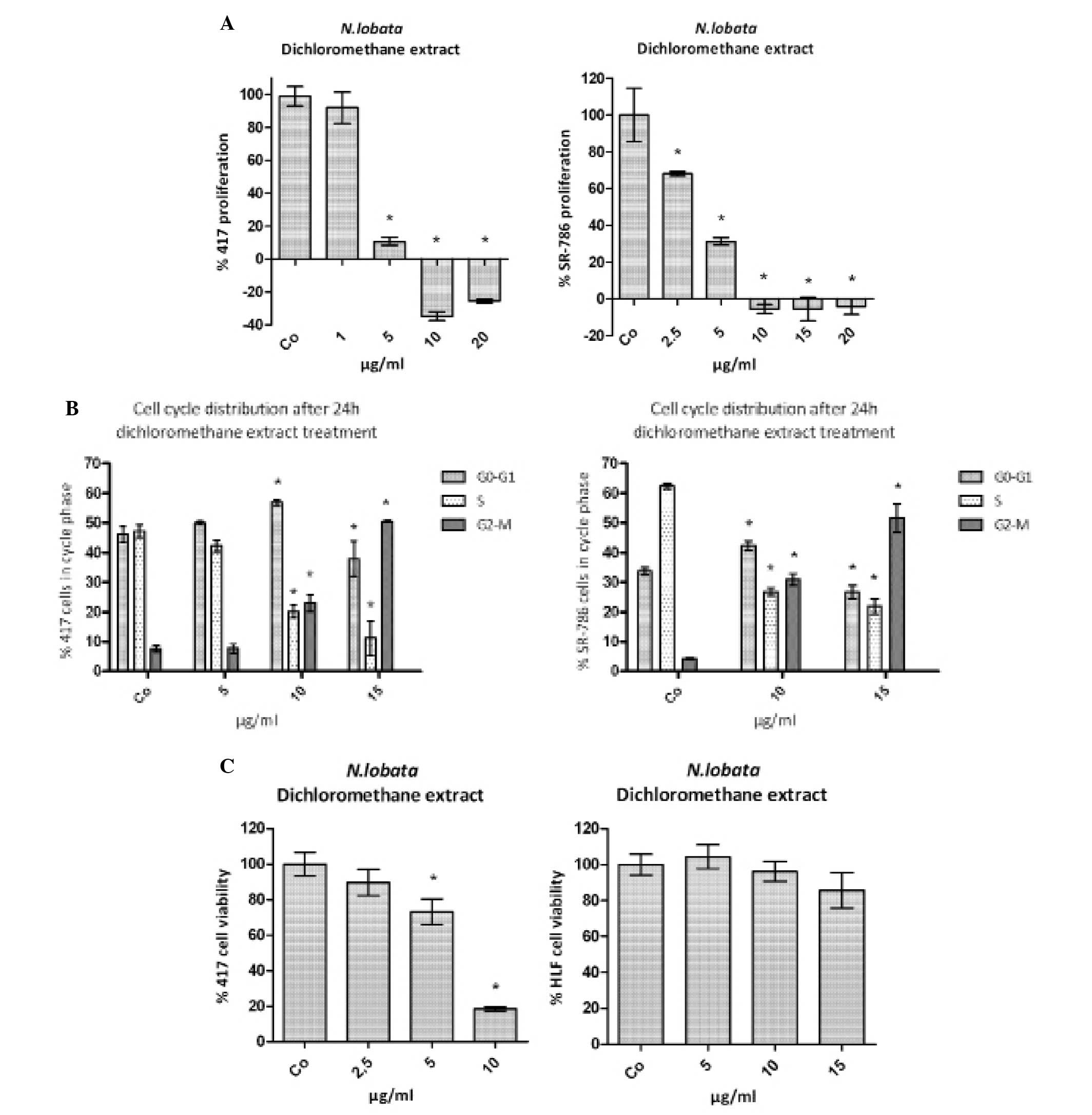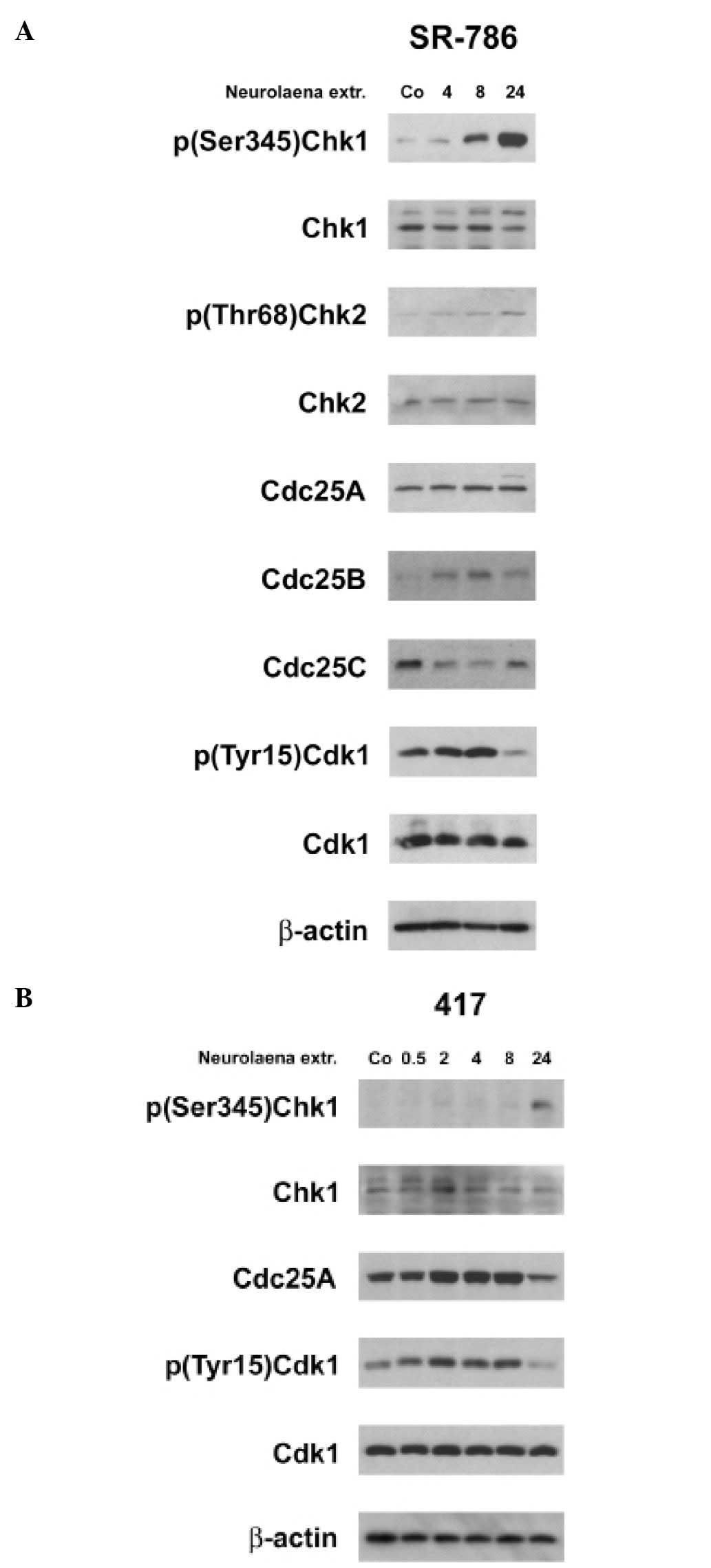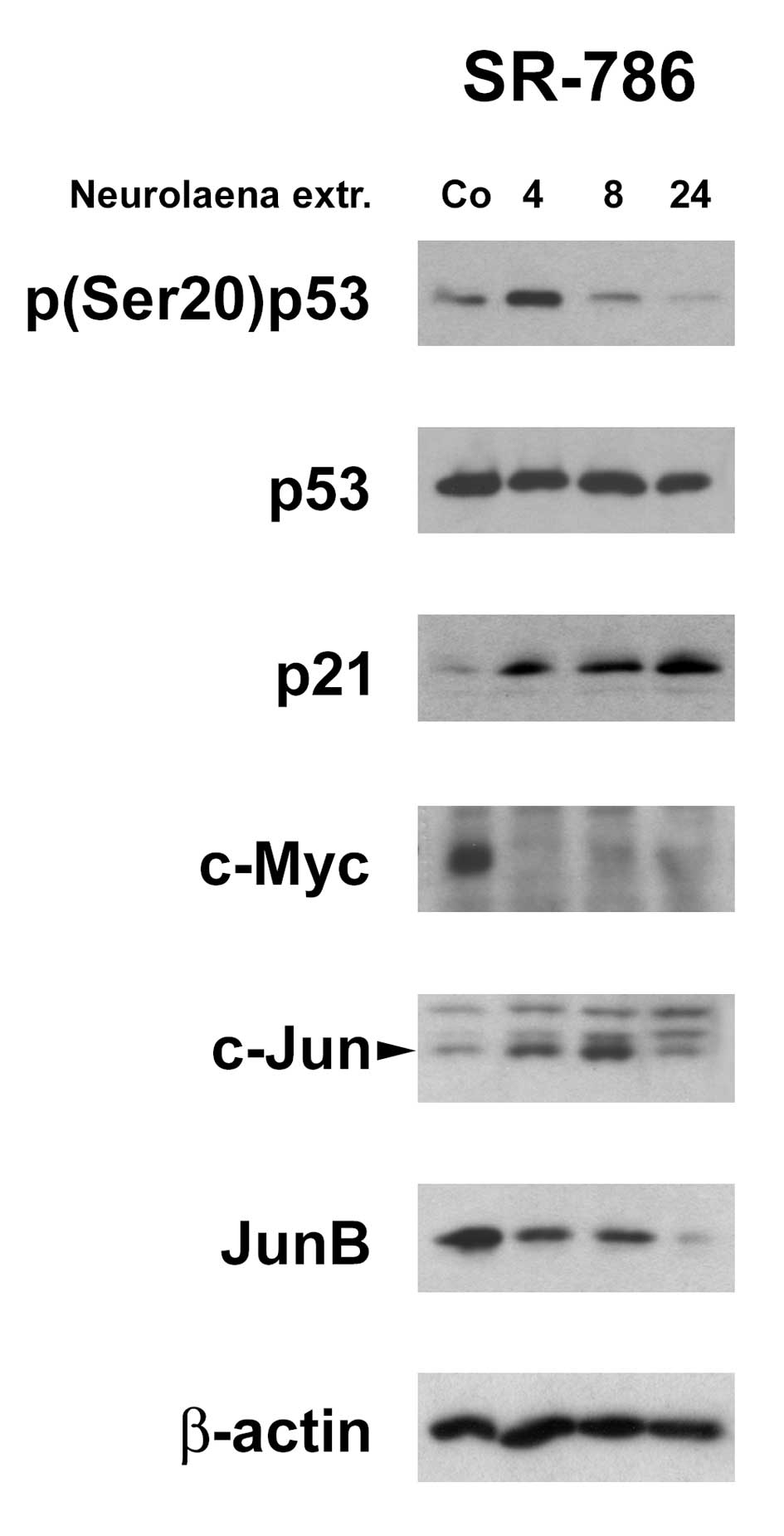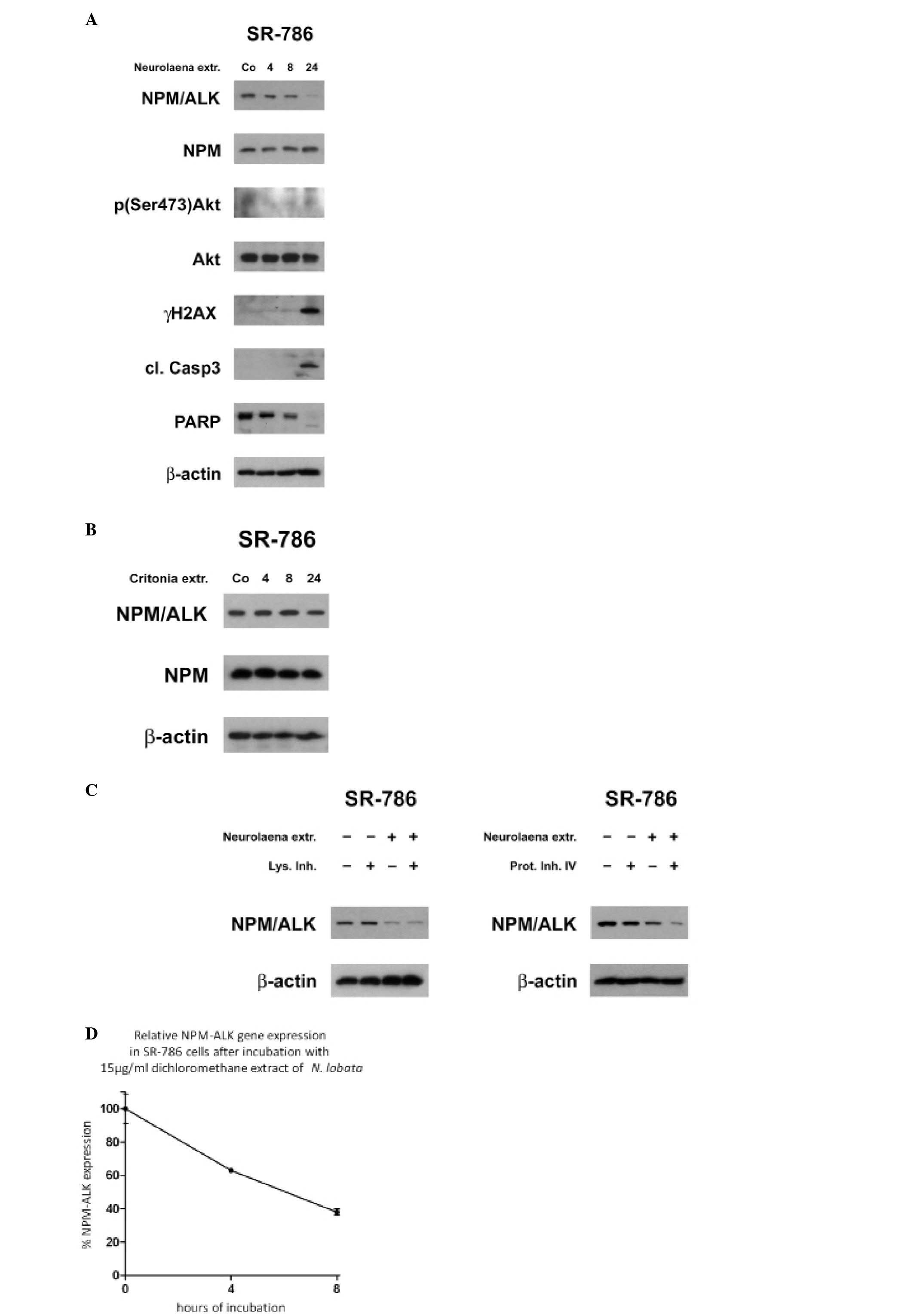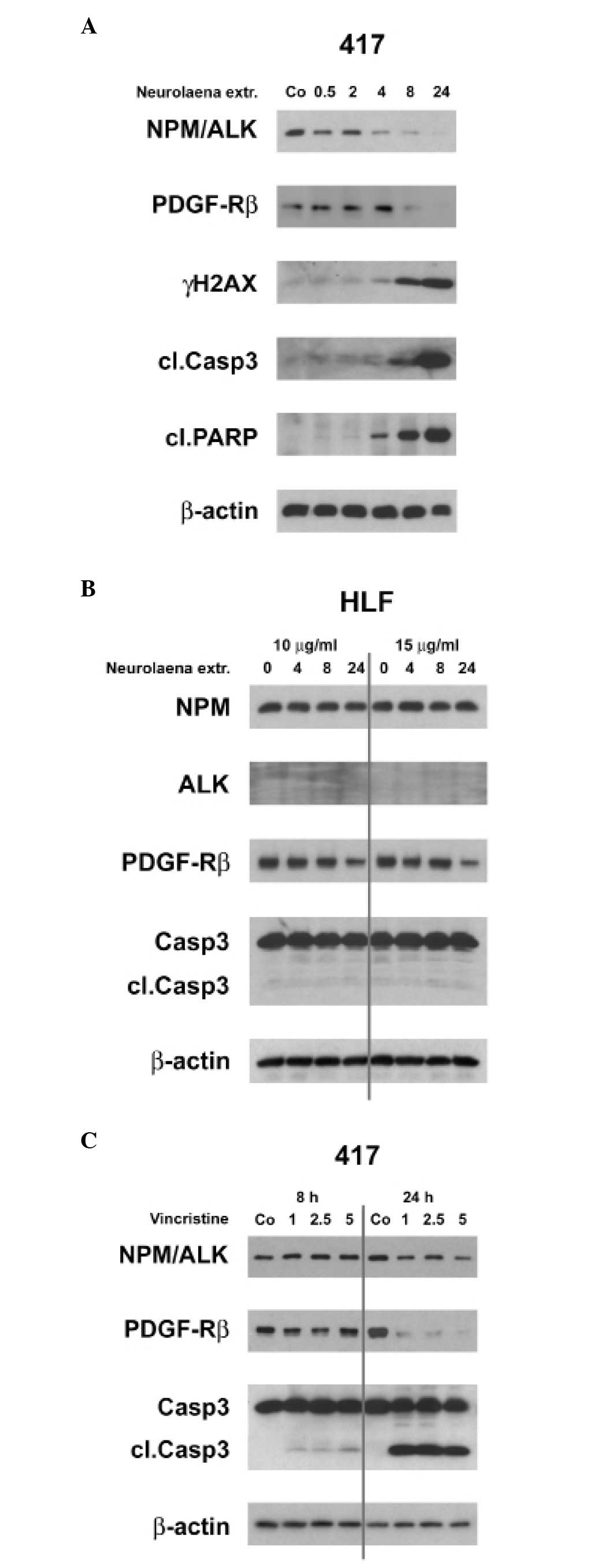|
1.
|
Koehn FE and Carter GT: The evolving role
of natural products in drug discovery. Nat Rev Drug Discov.
4:206–220. 2005. View
Article : Google Scholar : PubMed/NCBI
|
|
2.
|
Cragg GM and Newman DJ: Natural Product
Sources of Drugs: Plants, Microbes, Marine Organisms, and Animals.
Comprehensive Medicinal Chemistry II. Chapter 1.08. 355–403.
2007.
|
|
3.
|
Gidding CE, Kellie SJ, Kamps WA and de
Graaf SS: Vincristine revisited. Crit Rev Oncol Hematol.
29:267–287. 1999. View Article : Google Scholar
|
|
4.
|
Arvigo R and Balick M: Rainforest
Remedies. 2nd edition. Lotus Press; Twin Lakes, WI: 1998
|
|
5.
|
Berger I, Passreiter CM, Cáceres A and
Kubelka W: Antiprotozoal activity of Neurolaena lobata.
Phytother Res. 15:327–330. 2001. View Article : Google Scholar : PubMed/NCBI
|
|
6.
|
Gupta MP, Solis NG, Avella ME and Sanchez
C: Hypoglycemic activity of Neurolaena lobata (L.) R. Br J
Ethnopharmacol. 10:323–327. 1984.
|
|
7.
|
Bedoya LM, Alvarez A, Bermejo M, González
N, Beltrán M, Sánchez-Palomino S, Cruz SM, Gaitán I, del Olmo E,
Escarcena R, García PA, Cáceres A, San Feliciano A and Alcamí J:
Guatemalan plants extracts as virucides against HIV-1 infection.
Phytomedicine. 15:520–524. 2008. View Article : Google Scholar : PubMed/NCBI
|
|
8.
|
Passreiter CM, Wendisch D and Gondol D:
Sesquiterpene lactones from Neurolaena lobata.
Phytochemistry. 39:133–137. 1995. View Article : Google Scholar
|
|
9.
|
François G, Passreiter C, Woerdenbag H and
van Looveren M: Antiplasmodial activities and cytotoxic effects of
aqueous extracts and sesquiterpene lactones from Neurolaena
lobata. Planta Med. 62:126–129. 1996.PubMed/NCBI
|
|
10.
|
Berger I, Barrientos AC, Cáceres A,
Hernández M, Rastrelli L, Passreiter CM and Kubelka W: Plants used
in Guatemala for the treatment of protozoal infections: II.
Activity of extracts and fractions of five Guatemalan plants
against Trypanosoma cruzi. J Ethnopharmacol. 62:107–115. 1998.
View Article : Google Scholar : PubMed/NCBI
|
|
11.
|
Morris SW, Kirstein MN, Valentine MB,
Dittmer KG, Shapiro DN, Saltman DL and Look AT: Fusion of a kinase
gene, ALK, to a nucleolar protein gene, NPM, in non-Hodgkin’s
lymphoma. Science. 263:1281–1284. 1994.
|
|
12.
|
Stein H, Foss HD, Dürkop H, Marafioti T,
Delsol G, Pulford K, Pileri S and Falini B: CD30(+) anaplastic
large cell lymphoma: a review of its histopathologic, genetic, and
clinical features. Blood. 96:3681–3695. 2000.
|
|
13.
|
Piva R, Chiarle R, Manazza AD, Taulli R,
Simmons W, Ambrogio C, D’Escamard V, Pellegrino E, Ponzetto C,
Palestro G and Inghirami G: Ablation of oncogenic ALK is a viable
therapeutic approach for anaplastic large-cell lymphomas. Blood.
107:689–697. 2006. View Article : Google Scholar : PubMed/NCBI
|
|
14.
|
Simonitsch I, Polgar D, Hajek M, Duchek P,
Skrzypek B, Fassl S, Lamprecht A, Schmidt G, Krupitza G and Cerni
C: The cytoplasmic truncated receptor tyrosine kinase ALK homodimer
immortalizes and cooperates with ras in cellular transformation.
FASEB J. 15:1416–1428. 2001.PubMed/NCBI
|
|
15.
|
Meadows AT, Friedman DL, Neglia JP,
Mertens AC, Donaldson SS, Stovall M, Hammond S, Yasui Y and Inskip
PD: Second neoplasms in survivors of childhood cancer: findings
from the Childhood Cancer Survivor Study cohort. J Clin Oncol.
27:2356–2362. 2009. View Article : Google Scholar : PubMed/NCBI
|
|
16.
|
Reiter A: Diagnosis and treatment of
childhood non-Hodgkin lymphoma. Hematology Am Soc Hematol Educ
Program. 285–296. 2007. View Article : Google Scholar
|
|
17.
|
Freed J and Kelly KM: Current approaches
to the management of pediatric Hodgkin lymphoma. Paediatr Drugs.
12:85–98. 2010. View Article : Google Scholar : PubMed/NCBI
|
|
18.
|
Palmer RH, Vernersson E, Grabbe C and
Hallberg B: Anaplastic lymphoma kinase: signalling in development
and disease. Biochem J. 420:345–361. 2009. View Article : Google Scholar : PubMed/NCBI
|
|
19.
|
Hallberg B and Palmer RH: Crizotinib -
latest champion in the cancer wars? N Engl J Med. 363:1760–1762.
2010. View Article : Google Scholar : PubMed/NCBI
|
|
20.
|
Maier S, Strasser S, Saiko P, Leisser C,
Sasgary S, Grusch M, Madlener S, Bader Y, Hartmann J, Schott H,
Mader RM, Szekeres T, Fritzer-Szekeres M and Krupitza G: Analysis
of mechanisms contributing to AraC-mediated chemoresistance and
re-establishment of drug sensitivity by the novel
heterodinucleoside phosphate 5-FdUrd-araC. Apoptosis. 11:427–440.
2006. View Article : Google Scholar : PubMed/NCBI
|
|
21.
|
Strasser S, Maier S, Leisser C, Saiko P,
Madlener S, Bader Y, Bernhaus A, Gueorguieva M, Richter S, Mader
RM, Wesierska-Gadek J, Schott H, Szekeres T, Fritzer-Szekeres M and
Krupitza G: 5-FdUrd-araC heterodinucleoside re-establishes
sensitivity in 5-FdUrd- and AraC-resistant MCF-7 breast cancer
cells overexpressing ErbB2. Differentiation. 74:488–498. 2006.
View Article : Google Scholar : PubMed/NCBI
|
|
22.
|
Fassl S, Leisser C, Huettenbrenner S,
Maier S, Rosenberger G, Strasser S, Grusch M, Fuhrmann G, Leuhuber
K, Polgar D, Stani J, Tichy B, Nowotny C and Krupitza G:
Transferrin ensures survival of ovarian carcinoma cells when
apoptosis is induced by TNFalpha, FasL, TRAIL, or Myc. Oncogene.
22:8343–8355. 2003. View Article : Google Scholar : PubMed/NCBI
|
|
23.
|
Leisser C, Rosenberger G, Maier S,
Fuhrmann G, Grusch M, Strasser S, Huettenbrenner S, Fassl S, Polgar
D, Krieger S, Cerni C, Hofer-Warbinek R, deMartin R and Krupitza G:
Subcellular localisation of Cdc25A determines cell fate. Cell Death
Differ. 11:80–89. 2004. View Article : Google Scholar : PubMed/NCBI
|
|
24.
|
Grusch M, Polgar D, Gfatter S, Leuhuber K,
Huettenbrenner S, Leisser C, Fuhrmann G, Kassie F, Steinkellner H,
Smid K, Peters GJ, Jayaram HN, Klepal W, Szekeres T, Knasmüller S
and Krupitza G: Maintenance of ATP favours apoptosis over necrosis
triggered by benzamide riboside. Cell Death Differ. 9:169–178.
2002. View Article : Google Scholar : PubMed/NCBI
|
|
25.
|
Livak KJ and Schmittgen TD: Analysis of
relative gene expression data using real-time quantitative PCR and
the 2[-Delta Delta C(T)] method. Methods. 25:402–408. 2001.
|
|
26.
|
Coller HA, Grandori C, Tamayo P, Colbert
T, Lander ES, Eisenman RN and Golub TR: Expression analysis with
oligonucleotide microarrays reveals that MYC regulates genes
involved in growth, cell cycle, signaling, and adhesion. Proc Natl
Acad Sci USA. 97:3260–3265. 2000. View Article : Google Scholar : PubMed/NCBI
|
|
27.
|
Mathas S, Hinz M, Anagnostopoulos I,
Krappmann D, Lietz A, Jundt F, Bommert K, Mechta-Grigoriou F, Stein
H, Dörken B and Scheidereit C: Aberrantly expressed c-Jun and JunB
are a hallmark of Hodgkin lymphoma cells, stimulate proliferation
and synergize with NF-kappa B. EMBO J. 21:4104–4113. 2002.
View Article : Google Scholar : PubMed/NCBI
|
|
28.
|
Staber PB, Vesely P, Haq N, Ott RG, Funato
K, Bambach I, Fuchs C, Schauer S, Linkesch W, Hrzenjak A, Dirks WG,
Sexl V, Bergler H, Kadin ME, Sternberg DW, Kenner L and Hoefler G:
The oncoprotein NPM-ALK of anaplastic large-cell lymphoma induces
JUNB transcription via ERK1/2 and JunB translation via mTOR
signaling. Blood. 110:3374–3383. 2007. View Article : Google Scholar : PubMed/NCBI
|
|
29.
|
Unger C, Popescu R, Giessrigl B, Rarova L,
Herbacek I, Seelinger M, Diaz R, Wallnöfer B, Fritzer-Szekeres M,
Szekeres T, Frisch R, Doležal K, Strnad M, De Martin R, Grusch M,
Kopp B and Krupitza G: An apolar extract of Critonia
morifolia inhibits c-Myc, cyclin D1, Cdc25A, Cdc25B, Cdc25C and
Akt and induces apoptosis. Int J Oncol. 40:2131–2139.
2012.PubMed/NCBI
|
|
30.
|
Slupianek A, Nieborowska-Skorska M, Hoser
G, Morrione A, Majewski M, Xue L, Morris SW, Wasik MA and Skorski
T: Role of phosphatidylinositol 3-kinase-Akt pathway in
nucleophosmin/anaplastic lymphoma kinase-mediated lymphomagenesis.
Cancer Res. 61:2194–2199. 2001.PubMed/NCBI
|
|
31.
|
Polgar D, Leisser C, Maier S, Strasser S,
Rüger B, Dettke M, Khorchide M, Simonitsch I, Cerni C and Krupitza
G: Truncated ALK derived from chromosomal translocation
t(2;5)(p23;q35) binds to the SH3 domain of p85-PI3K. Mutat Res.
570:9–15. 2005. View Article : Google Scholar : PubMed/NCBI
|
|
32.
|
Cockle SM and Dean RT: The regulation of
proteolysis in normal fibroblasts as they approach confluence.
Evidence for the participation of the lysosomal system. Biochem J.
208:795–800. 1982.PubMed/NCBI
|
|
33.
|
Laimer D, Dolznig H, Kollmann K, Vesely
PW, Schlederer M, Merkel O, Schiefer AI, Hassler MR, Heider S,
Amenitsch L, Thallinger C, Staber PB, Simonitsch-Klupp I, Artaker
M, Lagger S, Turner SD, Pileri S, Piccaluga PP, Valent P, Messana
K, Landra I, Weichhart T, Knapp S, Shehata M, Todaro M, Sexl V,
Höfler G, Piva R, Medico E, Ruggeri BA, Cheng M, Eferl R, Egger G,
Penninger JM, Jaeger U, Moriggl R, Inghirami G and Kenner L: PDGFR
blockade is a rational and effective therapy for NPM-ALK driven
lymphomas. Nat Med. (In press).
|
|
34.
|
Andrae J, Gallini R and Betsholtz C: Role
of platelet-derived growth factors in physiology and medicine.
Genes Dev. 22:1276–1312. 2008. View Article : Google Scholar : PubMed/NCBI
|
|
35.
|
Jechlinger M, Sommer A, Moriggl R, Seither
P, Kraut N, Capodiecci P, Donovan M, Cordon-Cardo C, Beug H and
Grünert S: Autocrine PDGFR signaling promotes mammary cancer
metastasis. J Clin Invest. 116:1561–1570. 2006. View Article : Google Scholar : PubMed/NCBI
|
|
36.
|
Ergin M, Denning MF, Izban KF, Amin HM,
Martinez RL, Saeed S and Alkan S: Inhibition of tyrosine kinase
activity induces caspase-dependent apoptosis in anaplastic large
cell lymphoma with NPM-ALK (p80) fusion protein. Exp Hematol.
29:1082–1090. 2001. View Article : Google Scholar : PubMed/NCBI
|
|
37.
|
Gridling M, Stark N, Madlener S, Lackner
A, Popescu R, Benedek B, Diaz R, Tut FM, Nha Vo TP, Huber D,
Gollinger M, Saiko P, Ozmen A, Mosgoeller W, De Martin R, Eytner R,
Wagner KH, Grusch M, Fritzer-Szekeres M, Szekeres T, Kopp B, Frisch
R and Krupitza G: In vitro anti-cancer activity of two
ethno-pharmacological healing plants from Guatemala Pluchea
odorata and Phlebodium decumanum. Int J Oncol.
34:1117–1128. 2009.
|
|
38.
|
Stark N, Gridling M, Madlener S, Bauer S,
Lackner A, Popescu R, Diaz R, Tut FM, Vo TP, Vonach C, Giessrigl B,
Saiko P, Grusch M, Fritzer-Szekeres M, Szekeres T, Kopp B, Frisch R
and Krupitza G: A polar extract of the Maya healing plant Anthurium
schlechtendalii (Aracea) exhibits strong in vitro anticancer
activity. Int J Mol Med. 24:513–521. 2009.PubMed/NCBI
|
|
39.
|
Madlener S, Svacinová J, Kitner M, Kopecky
J, Eytner R, Lackner A, Vo TP, Frisch R, Grusch M, De Martin R,
Dolezal K, Strnad M and Krupitza G: In vitro
anti-inflammatory and anticancer activities of extracts of
Acalypha alopecuroidea (Euphorbiaceae). Int J Oncol.
35:881–891. 2009.
|
|
40.
|
Ozmen A, Bauer S, Gridling M, Singhuber J,
Krasteva S, Madlener S, Vo TP, Stark N, Saiko P, Fritzer-Szekeres
M, Szekeres T, Askin-Celik T, Krenn L and Krupitza G: In
vitro anti-neoplastic activity of the ethno-pharmaceutical
plant Hypericum adenotrichum Spach endemic to Western Turkey. Oncol
Rep. 22:845–852. 2009.
|
|
41.
|
Ozmen A, Madlener S, Bauer S, Krasteva S,
Vonach C, Giessrigl B, Gridling M, Viola K, Stark N, Saiko P,
Michel B, Fritzer-Szekeres M, Szekeres T, Askin-Celik T, Krenn L
and Krupitza G: In vitro anti-leukemic activity of the
ethno-pharmacological plant Scutellaria orientalis ssp carica
endemic to western Turkey. Phytomedicine. 17:55–62. 2010.
View Article : Google Scholar
|
|
42.
|
Vo NT, Madlener S, Bago-Horvath Z,
Herbacek I, Stark N, Gridling M, Probst P, Giessrigl B, Bauer S,
Vonach C, Saiko P, Grusch M, Szekeres T, Fritzer-Szekeres M, Jäger
W, Krupitza G and Soleiman A: Pro- and anticarcinogenic mechanisms
of piceatannol are activated dose dependently in MCF-7 breast
cancer cells. Carcinogenesis. 31:2074–2081. 2010. View Article : Google Scholar : PubMed/NCBI
|
|
43.
|
Khan M, Giessrigl B, Vonach C, Madlener S,
Prinz S, Herbaceck I, Hölzl C, Bauer S, Viola K, Mikulits W,
Quereshi RA, Knasmüller S, Grusch M, Kopp B and Krupitza G:
Berberine and a Berberis lycium extract inactivate Cdc25A and
induce alpha-tubulin acetylation that correlate with HL-60 cell
cycle inhibition and apoptosis. Mutat Res. 683:123–130. 2010.
View Article : Google Scholar : PubMed/NCBI
|
|
44.
|
Bauer S, Singhuber J, Seelinger M, Unger
C, Viola K, Vonach C, Giessrigl B, Madlener S, Stark N, Wallnofer
B, Wagner KH, Fritzer-Szekeres M, Szekeres T, Diaz R, Tut F, Frisch
R, Feistel B, Kopp B, Krupitza G and Popescu R: Separation of
anti-neoplastic activities by fractionation of a Pluchea odorata
extract. Front Biosci (Elite Ed). 3:1326–1336. 2011.PubMed/NCBI
|
|
45.
|
Madlener S, Saiko P, Vonach C, Viola K,
Huttary N, Stark N, Popescu R, Gridling M, Vo NT, Herbacek I,
Davidovits A, Giessrigl B, Venkateswarlu S, Geleff S, Jäger W,
Grusch M, Kerjaschki D, Mikulits W, Golakoti T, Fritzer-Szekeres M,
Szekeres T and Krupitza G: Multifactorial anticancer effects of
digalloyl-resveratrol encompass apoptosis, cell-cycle arrest, and
inhibition of lymphendothelial gap formation in vitro. Br J Cancer.
102:1361–1370. 2010. View Article : Google Scholar : PubMed/NCBI
|
|
46.
|
Kerjaschki D, Bago-Horvath Z, Rudas M,
Sexl V, Schneckenleithner C, Wolbank S, Bartel G, Krieger S, Kalt
R, Hantusch B, Keller T, Nagy-Bojarszky K, Huttary N, Raab I,
Lackner K, Krautgasser K, Schachner H, Kaserer K, Rezar S, Madlener
S, Vonach C, Davidovits A, Nosaka H, Hämmerle M, Viola K, Dolznig
H, Schreiber M, Nader A, Mikulits W, Gnant M, Hirakawa S, Detmar M,
Alitalo K, Nijman S, Offner F, Maier TJ, Steinhilber D and Krupitza
G: Lipoxygenase mediates invasion of intrametastatic lymphatic
vessels and propagates lymph node metastasis of human mammary
carcinoma xenografts in mouse. J Clin Invest. 121:2000–2012. 2011.
View Article : Google Scholar
|
|
47.
|
Passreiter CM: Pyrrolizidine alkaloids
from Neurolaena lobata. Biochem Sys Ecol. 26:839–843. 1998.
View Article : Google Scholar
|
|
48.
|
Ghantous A, Gali-Muhtasib H, Vuorela H,
Saliba NA and Darwiche N: What made sesquiterpene lactones reach
cancer clinical trials? Drug Discov Today. 15:668–678. 2010.
View Article : Google Scholar : PubMed/NCBI
|
|
49.
|
Zhang S, Won YK, Ong CN and Shen HM:
Anti-cancer potential of sesquiterpene lactones: bioactivity and
molecular mechanisms. Curr Med Chem Anticancer Agents. 5:239–249.
2005. View Article : Google Scholar : PubMed/NCBI
|
|
50.
|
Hsu FY, Johnston PB, Burke KA and Zhao Y:
The expression of CD30 in anaplastic large cell lymphoma is
regulated by nucleophosmin-anaplastic lymphoma kinase-mediated JunB
level in a cell type-specific manner. Cancer Res. 66:9002–9008.
2006. View Article : Google Scholar : PubMed/NCBI
|
|
51.
|
Gotzmann J, Fischer AN, Zojer M, Mikula M,
Proell V, Huber H, Jechlinger M, Waerner T, Weith A, Beug H and
Mikulits W: A crucial function of PDGF in TGF-beta-mediated cancer
progression of hepatocytes. Oncogene. 25:3170–3185. 2006.
View Article : Google Scholar : PubMed/NCBI
|
|
52.
|
Cáceres A, López B, González S, Berger I,
Tada I and Maki J: Plants used in Guatemala for the treatment of
protozoal infections. I Screening of activity to bacteria, fungi
and American trypanosomes of 13 native plants. J Ethnopharmacol.
62:195–202. 1998.PubMed/NCBI
|















